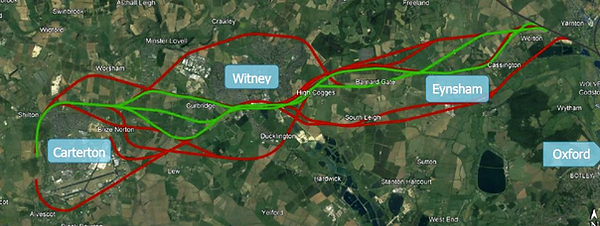3.1 Passenger Rail and Car-free Communities in West Oxfordshire
_edited.jpg)
Passenger trains ran between Oxford and Witney until 1962
Car-free communities need passenger rail and passenger rail needs car-free communities. But target transport users currently own cars, which meet all their transport needs, and paying for alternatives at the same time significantly increases costs.
.png)
Transport Groups
Every year, UK households spend £150 billion on private cars. The objective here is to shift this existing spend to sustainable alternatives, rather than adding more money. This also avoids savings, made by owning fewer cars, being used in other high emission sectors.
Transport Groups is a Web3 solution that uses smart contracts to connect interdependent assets, such as passenger rail, car-free housing and commercial space, before they’re built.
In this use case, finance for developing rail and car-free housing are made conditional on each other. The repayment of investment in rail is tied into rent and service charges for housing. Establishing supply and demand online, before changes are made on the ground, makes this similar to crowdfunding.
Residents of car-free housing build equity in shared transport infrastructure through their rent or service charges. Equity can be sold when they move, turning everyday payments into long-term ownership and value. A reduction in the number of private cars can also be used to validate Voluntary Carbon Credits, providing a revenue stream to cover rail operating costs.
Oxfordshire Rail and Car-Free Communities
5,000 car-free homes along the proposed Carterton–Witney–Oxford rail corridor would eliminate over 7,500 private cars. Each household unlocking up to £6,000 per year, by not owning the current average of 1.5 cars.
An estimated £1 billion is required to build the proposed railway. A smart contract allocates £3,000 per year per household through rent or service charges, repaying that investment over 65 years. In return, households receive digital tokens linked to the value of new infrastructure. This turns rent into equity and gives residents a real stake in the system they depend on.
As demand for Voluntary Carbon Credits (VCC) increases, the value of VCC validated by owning 7500 fewer cars will soon be high enough to cover the £3 million operating costs of the new rail services, estimated in the report below. This makes rail free at the point of use during a 2 year transition to low carbon transport.
Transport Groups is a DePIN* project, with DAO based governance, in which users and providers co-own and govern the development and operation of new transport services. *DePIN: Decentralised Physical Infrastructure Network
West Oxfordshire District Council report:
.png)
Shortlisted routes highlighted in green
Other possible 'Passenger Rail plus Car-free Housing' projects:
-
Passenger Rail in Arizona linking Phoenix with Tucson
-
The Koralm Railway in Austria linking Vienna with Klagenfurt
-
The ALTO High-Speed Rail Network linking Toronto with Quebec City
-
East West Rail linking Oxford and Cambridge